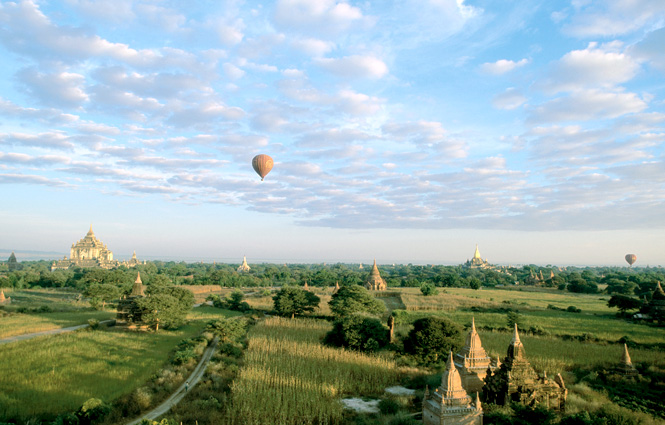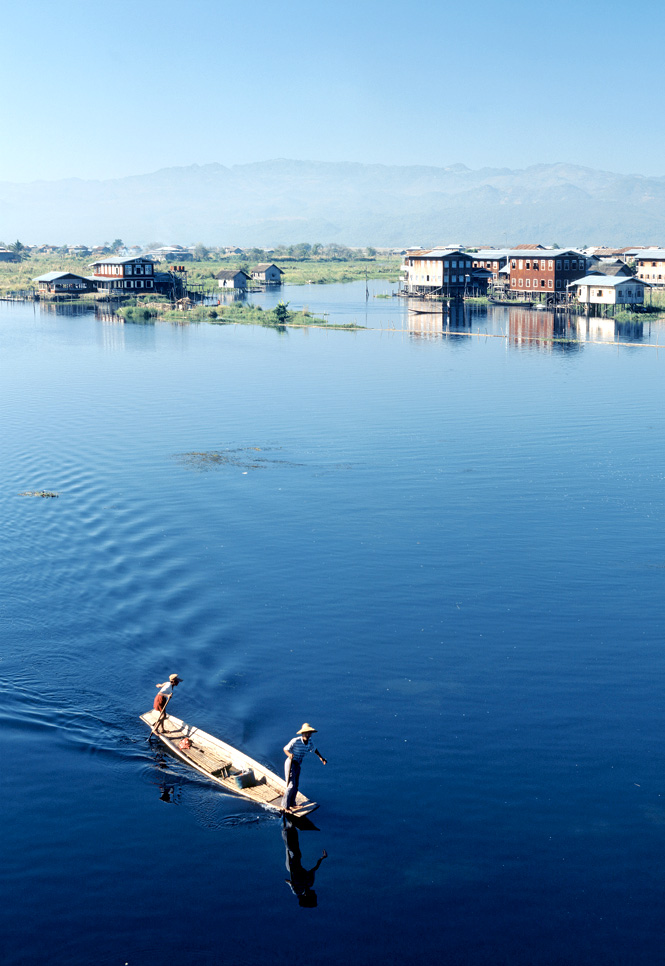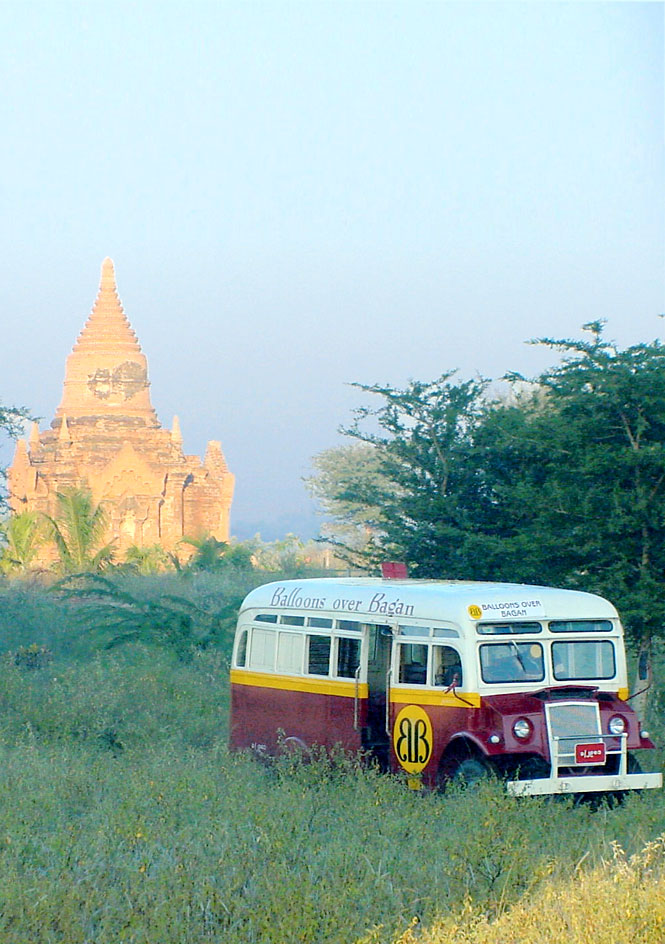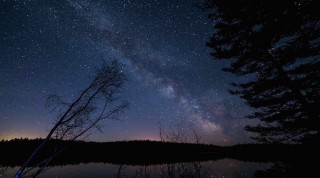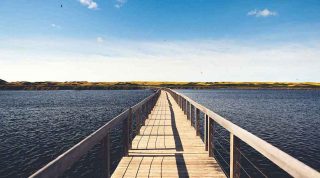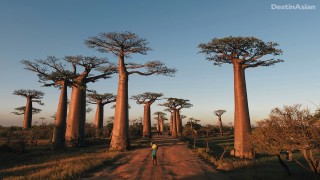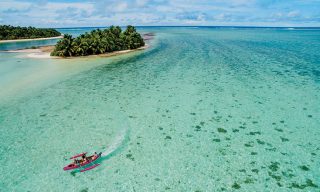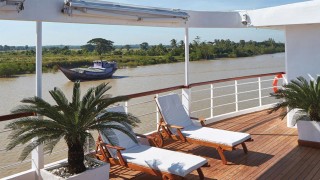Above: An Eastern Safaris hot-air balloon takes an early-morning flight over the temples of Bagan.
Ballooning over the Burmese countryside proves more than just a flight of fancy
By Charlie Norton
A charcoal mist wreathes the golden pagodas below us. Crows glide through the clouds, catching occasional drafts in the otherwise still sky. As the fog clears, we glimpse a line of saffron-robed monks waving from the base of a zedi, a gilded stupa. It’s our first bird’s-eye view of Myanmar, and it feels as though we’ve floated into a fairy tale.
We—a handful of British ballooning enthusiasts—have been invited to preview the six-day Grand Voyage Myanmar balloon “safari,” organized by adventure-tour operator Eastern Safaris and set to take to the skies this December. For close to 10 years, Eastern Safaris has run sunrise and sunset champagne flights over the ancient Burmese city of Bagan. Brett Melzer, an Australian who founded the company with his Burmese wife Khin Omar Win in 1999, tells me that he decided to expand the experience from 45 minutes to six days to give visitors greater insight into this spectacular yet tragic land.
“We wanted to create a more exclusive ballooning experience here, one that?harks back to the days of old-fashioned, luxury adventure travel,” Melzer says. Employing a staff of 60 locals, he has crafted an itinerary that combines on-the-ground sightseeing and cultural activities with a series of balloon flights over some of the country’s most beautiful countryside.
Myanmar, I am surprised to learn, has a ballooning tradition of its own. For generations, the Pa-O people of Taunggyi in Shan State have hosted an annual festival that sees the release of hundreds of paper balloons, some shaped like animals, others fashioned to resemble celestial pagodas. In the late 1920s, Burmese acrobat U Kyaw Yin took the activity to new heights. Launching a homespun, 14-meter-tall balloon made from white cotton, Kyaw Yin wowed compatriots with his sky-high antics: hanging upside down on an iron bar beneath the balloon, writhing and somersaulting as it soared toward the heavens. Over the next 10 years, the limber sexagenarian staged more than 55 flights across the country, donating a significant portion of his earnings to charity.
Myanmar also poses a dilemma for travelers: does visiting here help or harm a people who live under the heel of one of the world’s most repressive regimes? Aung San Suu Kyi, the country’s Nobel Peace Prize–winning opposition leader (who has spent most of the last 20 years under house arrest), believes that tourists should boycott Myanmar, lest the money they spend end up financing the junta. But tourism advocates like Melzer disagree, arguing that travelers can be a positive force, in terms of both local employment and social outreach. Indeed, Melzer was among a number of tourism operators who organized immediate fund-raising and relief efforts for the Irrawaddy Delta area in the wake of Cyclone Nargis last May.
His ballooning enterprise is no less community-minded. “We hire local staff and are working on a plan to donate US$100 from each guest’s balloon safari toward improving living standards,” he says. “We are trying to work this into the itinerary, so that there is an interactive element. Clients can see the money being put to good use, firsthand.”
Melzer’s Grand Voyage begins in Bagan, which served as the capital of successive Burmese kings until being overrun by Mongol invaders in 1287. Most of the 2,000 surviving shrines, stupas, and pagodas were built between the 11th and 13th centuries, and pepper an arid plain on the banks of the Irrawaddy River, about 145 kilometers downstream from Mandalay.
Our pilot is Lee Hooper, a 30-year-old Englishman with a decade of ballooning experience. “I’ve ballooned all over the world,” he tells us, “but nowhere as spectacular as Myanmar.” We launch just before dawn, the roaring whoosh of the gas burner breaking the early-morning silence. We ascend smoothly, brushing the treetops as the darkness begins to lift. Hooper chuckles. “Don’t worry; tree snakes can only jump a meter or so.”
Ballooning is a little like sailing, in that you’re at the mercy of the winds. It’s not always possible to control your route. “Balloons are useless as a mode of accurate transportation, for getting from point A to B,” Hooper says as we catch a thermal and dogleg to the right. A crew of some 60 people scurries after us on the ground, navigating paths as best they can to track the balloon as it moves through the sky. “That’s the beauty of it,” he adds. “It’s always a great adventure.”
An hour or so after we take flight we’re given the call to land: a one-minute warning to pull back from the edge of the basket and prepare for touchdown. Half a dozen of the ground crew leap up and cling to the trail rope Hooper drops, guiding us to a smooth landing in a wide, sandy plain. The boys who greet us clearly enjoy being part of the crew; they rush around packing up the balloon and safety gear, which will be transported by truck to Pindaya, some 200 kilometers to the east on the Shan Plateau.
While they work, we’re transferred to an aircraft of a different type: a chartered turboprop that takes us on a short flight to the village of Heho, gateway to Pindaya and Inle Lake, Myanmar’s second largest body of water. As we approach the airfield we spot remnants of bunker revetments and bomb craters—a stark reminder of Japan’s invasion of British-ruled Burma during World War II.
Upon landing, we’re whisked off in our next conveyance: a smartly restored bus that once plied the streets of Yangon. Now gleaming and fitted with Art Deco–style armchairs, it carries us east through fields awash in color: vibrant greens and yellows against a cloudless blue sky. The road begins to wind as we climb into the Shan Mountains, passing hilltop hamlets and whitewashed pagodas. We arrive in Pindaya, 1,200 meters above sea level, in the late afternoon, looking forward to our dusk flight over the peaks we’ve just traversed. But strong winds whip through the valley, so Hooper decides to postpone the flight until the following morning.
While grounded, we are content to explore Pindaya’s fabled limestone cave system. Like Bagan, the area is an overwhelming collage of Buddhist history, and remains one of the most important pilgrimage sites in Myanmar. There are three caves on the ridge outside town, but only the southernmost one, Shwe U Min, is worth visiting. Inside are more than 8,000 Buddhist images and statues dating back to the Konbaung period of the late 1700s. Our guides regale us with stories and legends behind the iconography around us. They tell us about Prince Kummabhaya’s daring rescue of seven princesses from a giant spider, and point out a blocked underground passageway that supposedly leads all the way back to Bagan.
The next morning is calm, offering ideal conditions for our dawn flight over the mountains. Wide-eyed Shan villagers smile as we clamber back into our basket and take off. As the sun rises behind us, the maroon-and-gold balloon casts a mammoth, moving shadow over the landscape: a patchwork quilt of wheat and mustard fields hemmed by rolling green hills.
Our flight the next day is even more memorable; it’s one of the first-ever balloon trips over Inle Lake. We’ve already seen this shimmering expanse of water from a distance—it’s not far from Pindaya—but only when we’re hanging above it do we appreciate the lake’s life-giving significance. Some 70,000 people known as the Intha (“children of the lake”) live on these shores, along with a handful of other ethnic groups. We drift over their floating water gardens at chimney height, mesmerized by the comings and goings of daily lake life: fishermen casting their nets; boats laden with produce on their way to market; children splashing amid the labyrinth of canals. At this height, however, there’s not enough wind to carry us across the water, so Hooper takes us up another 1,000 meters in hopes of catching a breeze. By then we’ve drifted so far off track that we’re forced to land in a remote mountain village where, our guide tell us, the locals have not seen a foreigner—let alone a hot-air balloon—for 50 years. The entire community is on hand to greet us, and an impromptu lunch is prepared in the square. The ground crew comes to our “rescue” later in the afternoon: it’s taken them two hours to hike up the steep slope to where we sit, enjoying the sun while slurping spicy Shan noodles with Inle carp.
Back down at the lake, we check into the Inle Princess, not far from a village called Magyizin. Like the other businesses Eastern Safaris works with, the resort is privately owned, not state-run, so our money (in theory, anyway) won’t end up lining some general’s pocket. As the sun sets we take to the water in a small wooden boat. An Intha fisherman propels us through the reeds using a distinctive style of “leg rowing”—one leg planted at the stern, the other wrapped around an oar. We munch on wild strawberries and let the gentle waves lull us into a state of meditation. As the last of the day disappears, the lake takes on an orange glow, its inhabitants transformed into shadowy stick figures. I can’t help but wonder what it would look like from above.
Eastern Safaris (easternsafaris.com; 951/652-809) will run four six-day Grand Voyage Myanmar balloon safaris through December 2009, with the next season scheduled for December 2010; from US$5,000 per person.
Originally appeared in the April 2009 print issue of DestinAsian magazine (“Sky-High Safari”)

